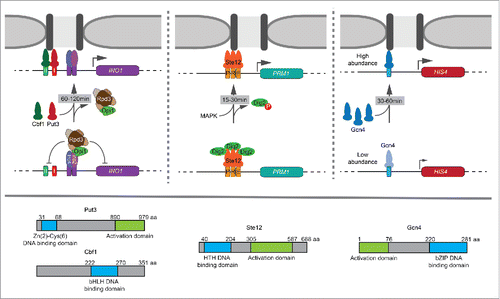Figures & data
Figure 1. Multiple strategies in regulating transcription factor (TF)-mediated recruitment to the nuclear periphery over different time scales. Top: (Left) Put3 and Cbf1 bind to GRSI and GRSII respectively in the promoter of INO1 and mediate its recruitment to the nuclear periphery upon inositol starvation. These TFs are regulated by the local recruitment of Rpd3(L) histone deacetylase by transcriptional repressors Opi1 and Ume6. Repression is relieved between 60–120 min leading to peripheral localization and interchromosomal clustering of INO1. (Middle) Ste12 mediates the recruitment of PRM1 to the nuclear periphery upon mating pheromone stimulation. Ste12 is regulated downstream of DNA binding by MAPK phosphorylation of the inhibitor Dig2. Phosphorylation of Dig2 and the recruitment of PRM1 occurs rapidly between 15–30 min. (Right) Gcn4-mediated recruitment of HIS4 to the nuclear periphery is controlled by Gcn4 abundance. Gcn4 is translationally regulated. Through increased protein levels of Gcn4, maximal peripheral targeting occurs between 30–60 min. Bottom: Graphical depiction of TF domains. Put3 is a Zn+2 – binuclear cluster TF. Cbf1 is a basic helix-loop-helix TF. Ste12 is a helix-turn-helix TF. Gcn4 is a basic leucine zipper TF.

